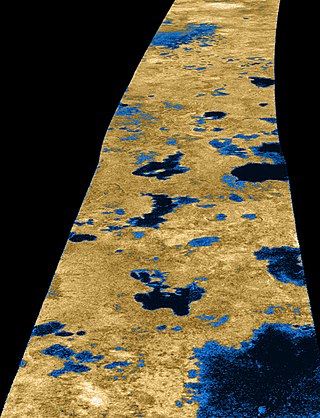
Lake Mackay, known as Wilkinkarra to the Indigenous Pintupi people, is the largest of hundreds of ephemeral salt lakes scattered throughout the Pilbara and northern parts of the Goldfields-Esperance region of Western Australia and the Northern Territory. It is located within the Great Sandy Desert.

Ontario Lacus is a lake composed of methane, ethane and propane near the south pole of Saturn's moon Titan. Its character as a hydrocarbon lake was confirmed by observations from the Cassini spacecraft, published in the 31 July 2008 edition of Nature. Ontario Lacus has a surface area of about 15,000 square kilometers (5,800 sq mi), about 20% smaller than its terrestrial namesake, Lake Ontario in North America. In April 2012, it was announced that it may be more like a mudflat or salt pan.

Lake Trichonida is the largest natural lake in Greece. It is situated in the eastern part of Aetolia-Acarnania, southeast of the city of Agrinio and northwest of Nafpaktos. It covers an area of 98.6 square kilometres (38.1 sq mi) with a maximum length of 19 kilometres (12 mi). Its surface elevation is 15 metres (49 ft) and its maximum depth is 58 metres (190 ft).

Lakes of ethane and methane on Titan, Saturn's largest moon, have been detected by the Cassini–Huygens space probe, and had been suspected long before. The large ones are known as maria (seas) and the small ones as lacūs (lakes).

Kraken Mare is the largest known body of liquid on the surface of Saturn's moon Titan. It was discovered by the space probe Cassini in 2006, and was named in 2008 after the Kraken, a legendary sea monster. It covers an area slightly bigger than the Caspian Sea on Earth, making it the largest known lake in the Solar System.

Ligeia Mare is a lake in the north polar region of Titan, the planet Saturn's largest moon. It is the second largest body of liquid on the surface of Titan, after Kraken Mare. Larger than Lake Superior on Earth, it is mostly composed of liquid methane, with unknown but lesser components of dissolved nitrogen and ethane, as well as other organic compounds. It is located at 78° N, 249° W, and has been fully imaged by the Cassini spacecraft. Measuring roughly 420 km (260 mi) by 350 km (217 mi) across, it has a surface area of about 126,000 km2, and a shoreline over 2,000 km (1,240 mi) in length. The lake may be hydrologically connected to the larger Kraken Mare. Its namesake is Ligeia, one of the sirens in Greek mythology.

Punga Mare is a lake in the north polar region of Titan, the planet Saturn's largest moon. After Kraken Mare and Ligeia Mare, it is the third largest known body of liquid on Titan. It is composed of liquid hydrocarbons. Located almost adjacent to the north pole at 85.1° N, 339.7° W, it measures roughly 380 km (236 mi) across, greater than the length of Lake Victoria on Earth. Its surface area is ~61,000 km2. Its namesake is Punga, in Māori mythology ancestor of sharks, rays and lizards and a son of Tangaroa, the god of the sea.

Jingpo Lacus is a lake in the north polar region of Titan, the planet Saturn's largest moon. It and similarly sized Ontario Lacus are the largest known bodies of liquid on Titan after the three maria. It is composed of liquid hydrocarbons. It is west of Kraken Mare at 73° N, 336° W, roughly 240 km long, similar to the length of Lake Onega on Earth. Its namesake is Jingpo Lake, a lake in China.

Abaya Lacus is one of a number of hydrocarbon lakes found on Saturn's largest moon, Titan.

Bolsena Lacus is one of a number of hydrocarbon lakes found on Saturn's largest moon, Titan.

Neagh Lacus is one of a number of hydrocarbon lakes found on Saturn's largest moon, Titan. The lake is composed of liquid methane and ethane, and was detected by the Cassini space probe.

Sotonera Lacus is one of a number of hydrocarbon lakes found on Saturn's largest moon, Titan.

Hammar Lacus is one of a number of hydrocarbon seas and lakes found on Saturn's largest moon, Titan.

Feia Lacus is one of a number of hydrocarbon seas and lakes found on Saturn's largest moon, Titan. It was named in 2007 on the basis of data taken by the space probe Cassini.

Koitere Lacus is one of a number of hydrocarbon lakes found on Saturn's largest moon, Titan. The lake is composed of liquid methane and ethane, and was detected by the space probe Cassini.

Müggel Lacus is one of a number of hydrocarbon seas and lakes found on Saturn's largest moon, Titan.

Ladoga Lacus is a geographical feature on Saturn's largest moon, Titan, named after Lake Ladoga, Russia. It is one of a number of "methane lakes" found in Titan's north polar region.

Sionascaig Lacus is one of a number of hydrocarbon seas and lakes found on Saturn's largest moon, Titan. The lake is located at latitude 41.52°S and longitude 278.12°W on Titan's globe, and is composed of liquid methane and ethane. The feature is named for the Earth lake, Loch Sionascaig, in Scotland.

Albano Lacus is one of a number of hydrocarbon lakes found on Saturn's largest moon, Titan.














